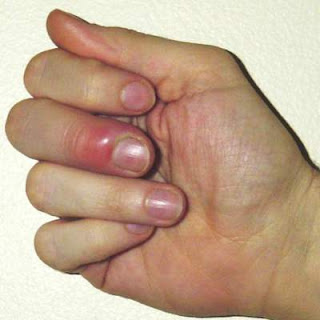What causes paronychia?
Paronychia is an inflammation of the proximal and/or lateral nail folds of a toe or finger.Paronychia is a tender, painful condition. Depending upon the causative factors and the length of morbidity period, the nail fold infection is termed as acute, chronic, candidal or pyogenic paronychia. Damage to the junction between nail plate and nail fold or to soft nail fold tissue surrounding the nail is the primary cause. Certain occupational exposures, cancers, certain systemic diseases and suppression of the immune response may also make a person susceptible nail fold infection.
Damage to eponychium, paronychium and hyponychium
The eponychium is the proximal nail fold that produces the cuticle cover on the proximal end of nail. Together with the cuticle, eponychium form a protective seal on the proximal end of nail plate.Paronychium or perionychium is the lateral nail fold. Paronychium is the soft tissue surrounding the lateral border of the fingernail or toenail. It protects from anything getting underneath the nail. Damage to paronychium may occur when any heavy object falls on the finger or toe and from biting or picking at hangnail, dishwashing, ingrown nail or any sharp object cutting or piercing it. Such damage can cause infection and acute paronychia.
The hyponychium is the tissue found beneath the nail plate at the junction between the free edge and the skin of the fingertip. It protects the nail bed. Damage to hyponychium may occur from dishwashing, injury from a splinter or thorn or nail biting. Any injury to hyponychium can cause infection.(see image below)
Paronychia caused by certain habits
Onychophagia or nail biting, is an oral compulsive habit. Nail biting causes deleterious effects in fingers such as broken skin on the cuticle, hangnails and damage to nail bed. The fingers become susceptible to microbial infections such as paronychia.(see image below) |
| image of acute paronychia compared to normal finger (Picture author: DRosenbach | CC BY-SA 3.0) |
 |
| picture of acute paronychia |
 |
| picture of chronic paronychia (Picture author: Rob Hille | CC BY-SA 3.0) |
 |
| picture of paronychia caused by picking at a hangnail |
Ingrown nail
Ingrown nail, especially toenail, is caused by the nail piercing and entering inside the paronychium. The condition leads to a microbial inflammation of the paronychium and nail fold infection. (see image below) |
| picture of paronychia caused by ingrown toenail |
Occupational exposures
Frequent bare hand contact with chemicals, detergents and medications can disrupt the bond between the nail fold and nail plate leading infection and inflammation.Dishwashing is an important triggering factor for chronic paronychia. The decaying food particles and dirt can get lodged between the nail plate and the skin fold. The cuticle may separate from the nail plate, leaving a gap between the proximal nail fold and the nail plate. This leads to paronychium inflammation and infection.
Dentists are frequently exposed to viral infections from oral fluids of patients and prone to develop viral nail fold infection or herpes whitlows.
Pathologists and laboratory workers handling tuberculotic cadaver and also veterinarians and butchers handling tuberculosis affected animals can develop prosector's paronychia when their nail and nail folds get inoculated by tubercle bacilli.
Other causes of paronychia
The carcinomas of the upper aerodigestive tract manifest as acrokeratosis paraneoplastica with symptoms like erythematous, keratotic rash and nail fold inflammation.Pemphigus, a blistering autoimmune diseases can show symptoms like nail fold inflammation.
Nail fold infection is more common in adult women, diabetics and people with weak immune systems.
Paronychia is also common in immunocompromised patients and those under drug-induced immunosuppression.
Advertisements
|
References: 1.Rigopoulos D, Larios G, Gregoriou S, Alevizos A. Acute and chronic paronychia. Am Fam Physician. 2008 Feb 1;77(3):339-46. 2.Shafritz AB, Coppage JM. Acute and chronic paronychia of the hand. J Am Acad Orthop Surg. 2014 Mar;22(3):165-74. |
No comments:
Post a Comment